Golf News editor Nick Bayly enjoys a whistlestop tour of some of finest links in County Donegal, including the recently opened St Patricks Links at Rosapenna, which is set to raise the bar still further in a part of North-West Ireland which is already blessed with more than its fair share of golfing riches
Those of a nervous disposition when it comes to flying best close their eyes and grab the hand of the person sitting next to them tightly when coming into land at Derry airport on a windy day. With the wings of our Loganair 48-seater jet dipping this way and that in the 30mph crosswind, and the plane seemingly about to land in the water, I feared that my golf trip to Donegal might be a somewhat shorter than I had hoped.
Thankfully, the skilled pilot landed us safely on terra firma, beyond the icy waters of the North Atlantic which end just yards from where the runway starts. After a something of a handbrake turn on landing, all the passengers disembarked with the look of relief normally reserved for the faces of novice golfers who manage to get their tee shot away on the first without breaking any windows or injuring an innocent bystander.
Weather aside, the flight from London Stansted to Derry is an absolute breeze if you’re coming from the south east of England, which I was, with a 65-minute flight taking you to the edge of the city, and but a short drive from many of the region’s magnificent golf courses. My time spent in Northern Ireland was as long as it took to drive through the western suburbs of Derry, and as the road signs on the A2 turned from delineating miles to kilometres, and the price of petrol was quoted in euros and not pounds, it didn’t take a rocket scientist or indeed a geography teacher to realise that I was now in the Republic.

Just over 45 minutes after leaving Derry I was driving through the gates at Ballyliffin Golf Club for the first appointment on my three-course itinerary, the 18 championship holes offered on the Glashedy Links.
Ballyliffin’s other course, the Old, as its name suggests, predates Glashedy Links by some 22 years, but it is the newcomer that is rated slightly higher in the course rankings due to the vision and skill of Pat Ruddy. Ruddy, who gained notoriety when creating the European Club, south of Dublin, first clapped eyes on the land that the Glashedy course now occupies in 1992 – the same year that the European Club opened – when he had been asked to come and renovate the bunkers on the Old Course. Such was his excitement that he told the club to forget about that bunker project and focus, instead, on developing a new course. Three years later, and just before the Irish government clamped down on the development of linksland, the Glashedy Links opened for play.
With the routing skilfully intertwined with the Old Course, the view from the elevated vantage point of the clubhouse bar can be quite overwhelming, with a vast moonscape of dunes interspersed with the odd ribbon of more closely mown turf stretching until the land meets the sea, between which there are 36 holes of championship golf – somewhere.
The newer course takes its name from the huge Glashedy Rock that can be seen from all angles and gives rise to comparisons with Turnberry. Measuring 7,200 yards off the backs, and with nine par fours over 400 yards, the Glashedy represents a serious test of any golfer’s talent, and although I played off the more manageable forward white tees (6,385 yards), gusting winds of 20-30mph ensured that it proved more than a match for my limited skillset.
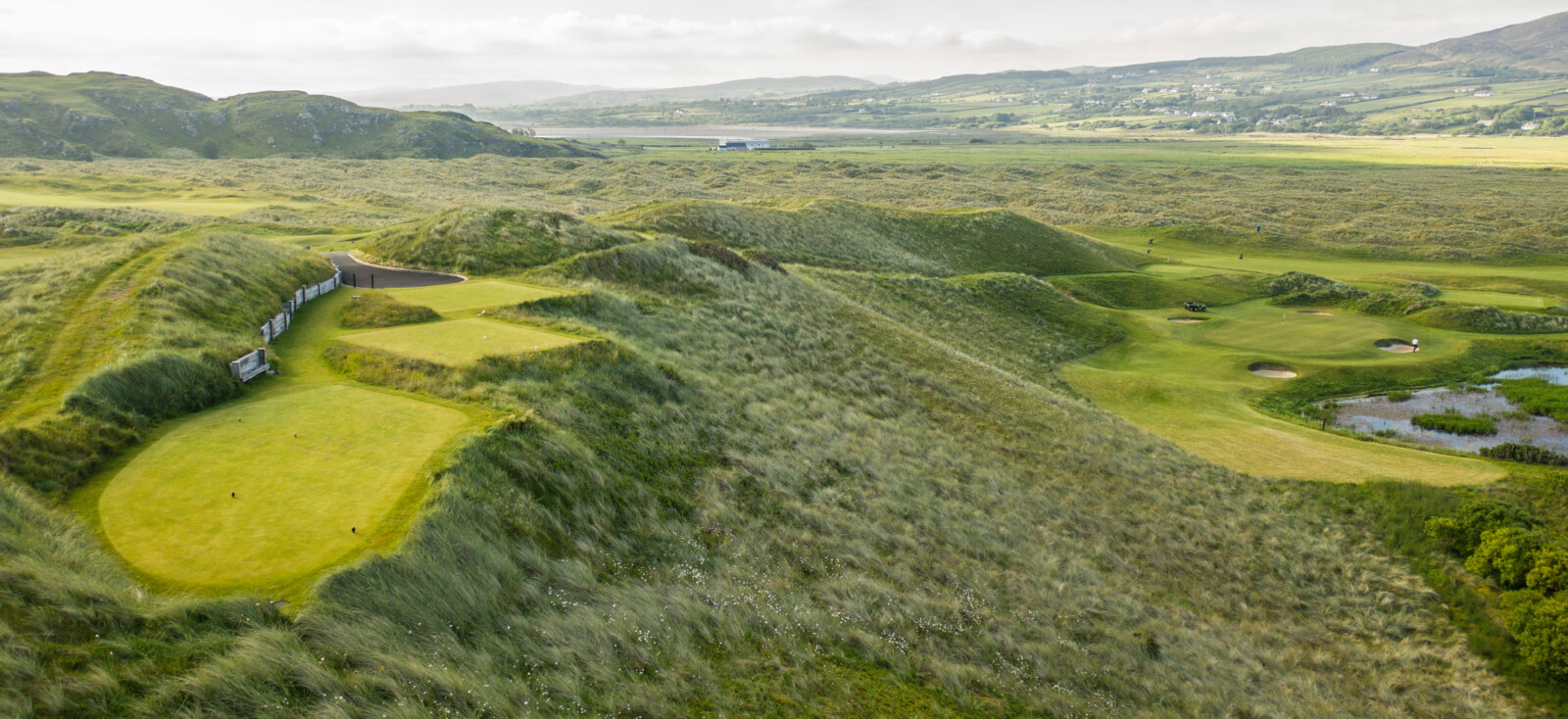
With narrow fairways, deep and plentiful bunkering, and even deeper and more penal rough, straight hitting is essential if you’re to have a sniff of making par and not losing a bucket load of balls. The outward nine is between 400-500 yards shorter than the front, depending on which tees you’re playing from, although that is offset by two of course’s three par-3s coming at 5 and 7. The round gets off to a tough start, with three consecutive par 4s of over 400 yards providing a stern early examination, with our group getting in plenty of bunker practice. The par-5 fourth presented my first sighter of a birdie, with the green being reachable with two wind-assisted blows. With towering dunes either side of the narrow fairway, it’s a perfectly framed hole that delights the eye. The sixth, a 370-yard dogleg par-4 is another personal highlight of the outward nine, with a well-placed drive to the ‘knee’ leaving a shortish shot into an angled green. Par here was celebrated like a birdie.
The 160-yard 7th, the second of the par threes, feels somewhat at odds with the rest of the course, with the tee towering 100 yards above a green which is protected by a large pond on the right-hand side. With a storm moving in as we struggled to stand up on the raised tee, it made for some entertainment, although none of us found the green at the first, or indeed, second attempt. NRs all around.

The run of five consecutive par fours from 8-12 seems a little repetitive when looking at the scorecard, but the reality presents distinctly different challenges, and 11 and 12 are excellent examples of their type. Things hot up at 13, a magnificent par-5 which ducks back in among the dunes, while the par-3 14th is a charming downhill hole which plays as short as 120 yards from the white tees to a green which is protected by a deep front bunker and steep-run offs to the back and sides.
Holes 15, 16 and 17 are often played into the teeth of the prevailing wind, with the 544-yard 17th feeling like one of those holes that never ends – yes, I took a seven and wasn’t too unhappy – while the round ends with a somewhat understated left-to-right 390-yard dogleg par-4 played to an angled green. All told, the Glashedy is one tough cookie, made even tougher on my visit by the wind and rain, although I imagine it would beat you up somewhat less on a calm, sunny summer’s day.
For me, there are perhaps too many holes where taking driver seemed too risky an option given the penalty for missing the fairway, which left very long second and third shots into greens that weren’t all designed to accept low-running approaches. Still, it’s an exhilarating experience and one that leaves you wanting to be a better golfer, which should be said of any course claiming true championship status.
After golf, my two fellow travellers and I holed up at the nearby Ballyliffin Hotel for some much-needed R&R, and where a steak pie and a few pints of the black stuff, followed by a restful night’s sleep, restored the batteries ahead of the following day’s visit to Rosapenna, an hour or so drive away.
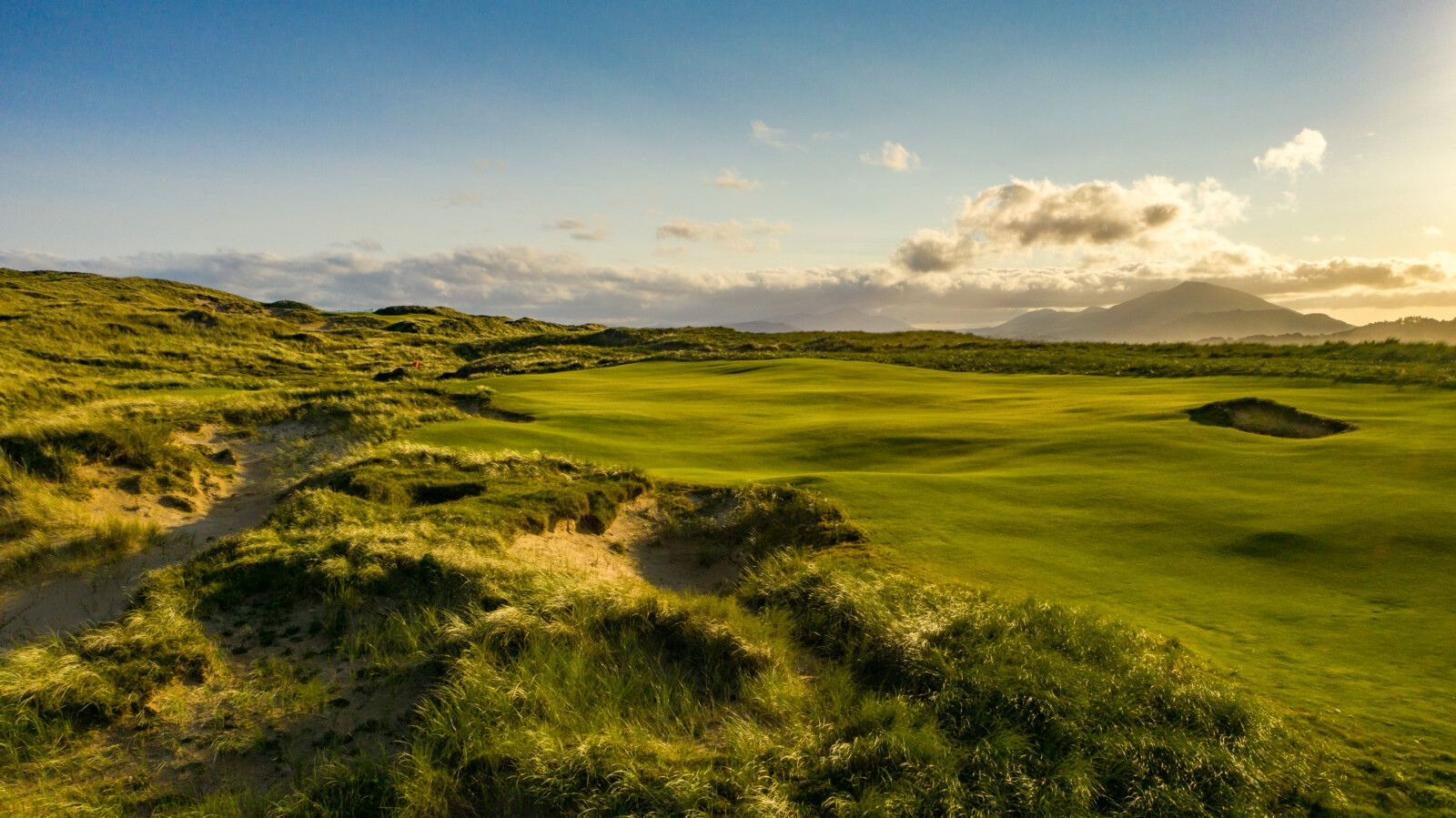
As the world’s coastal regions become a battleground between the economic demands of tourism and the desire to protect the natural environment, it is increasingly rare – and justifiably so – for pieces of land to be found that all parties agree are acceptable to develop a new golf course on. The developers behind St Patricks Links, the third 18-hole course at Rosapenna Resort, located hard on the shores of Sheephaven Bay, were fortunate to have no such troubles when it came to adding another course to the two that it already had on offer.
That was mainly down to the fact the venue for the new course was already the site for two pre-existing, and, so I’m told, rather humdrum layouts that the renowned golf course architect Tom Doak was tasked with transforming into one absolute belter to join the highly rated Old Tom Morris and Sandy Hills courses that have been attracting golfers from all over the world to Rosapena for decades. The initial project to carry out the transformation was halted by the economic crisis that unfolded back in 2008, and it was only after a change of Rosapena’s ownership in 2012, and the investment from the Casey family that followed, that plans to develop the 300-acre site into a new world-class links were reignited.
Construction of St Patricks Links began in 2018 and, give or take a few ill winds caused by the pandemic, the course opened for play in the summer of 2021. Naturally, in a world where people are quick to judge, some early reports were that the course was overhyped and overpriced, while other reviewers held diametrically opposing opinions, raving about the stunning setting, the unique design of the holes, and the sheer scale of the ambition.
Despite having all these conflicting views in my head, I arrived at the first tee at Patricks Links with an open mind and a clear head – I kept off the whiskey – and prepared to judge it only by my experience on the day. Having checked in at the Portakabin pro shop – the main golf clubhouse is several miles up the road next to the Rosapenna Golf Resort – I made my way to the first tee with a freshening breeze and under leaden October skies that looked ready to dump their cargo.
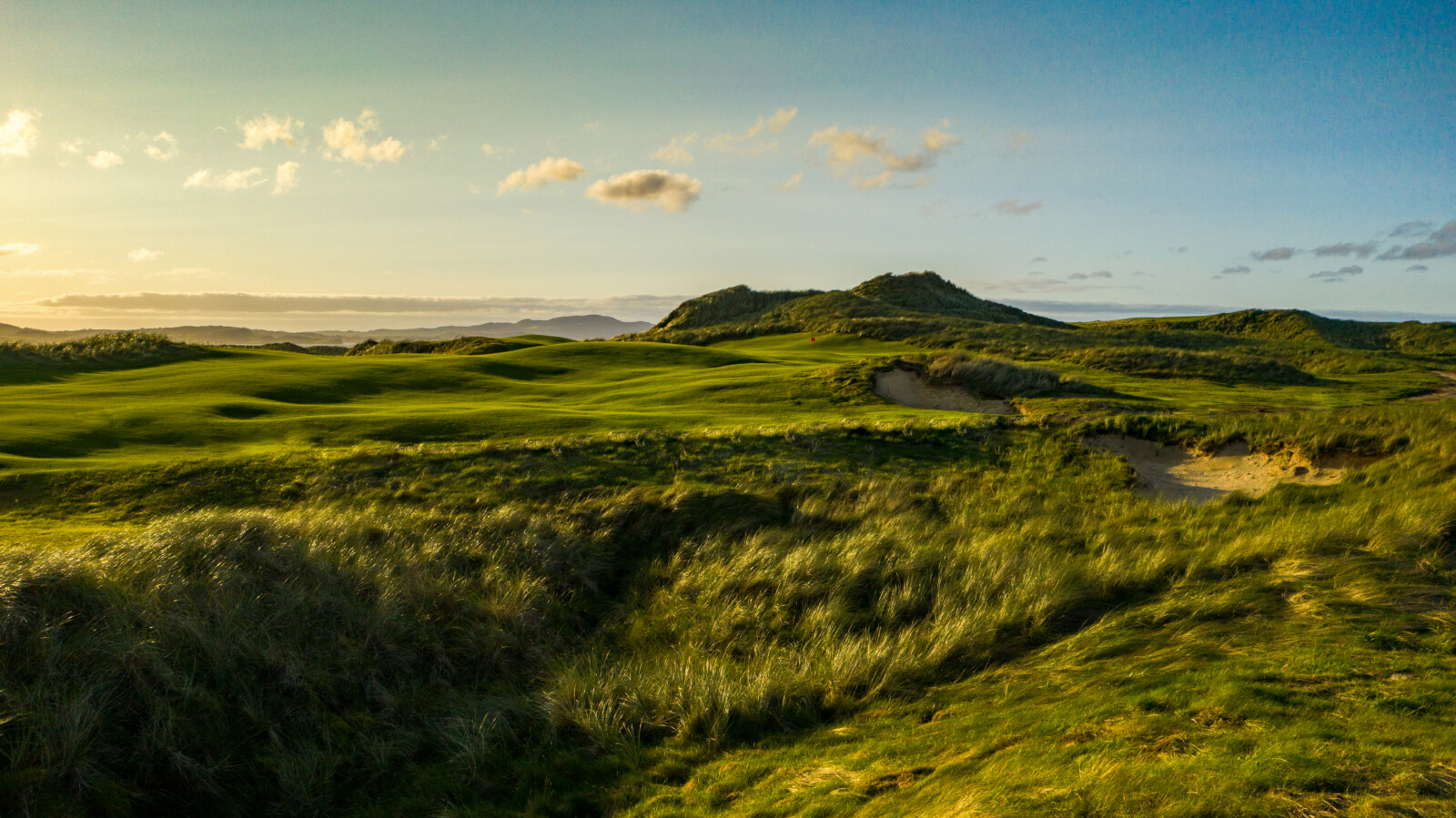
Armed with a course planner, a laser rangefinder and a dozen or so balls, I was later glad I had loaded up on the latter, as playing a new course on your own – my previous day’s partners were playing elsewhere – makes keeping your head down while watching where your ball went a tricky task at the best of times. The course gets off to a cracking start with the opening par-4 played from a raised tee to a fairway boarded by towering dunes on either side, with the green tucked around the corner of a right-to-left dogleg. As I later discovered, this hole provided the perfect snapshot of the St Patricks Links experience.
First off, and it was apparent right from my first putt that the greens have plenty of maturing to do. With poor growth caused by the summer’s drought, they will take a few seasons to properly establish themselves, so if you can take that into consideration then all good and well. If not, it might be best to give it a few years. Your call. With that elephant in the room, and duly noted, the rest of the course looks like it has been around for years, with the rumpled fairways threading their way like a green baize in between towering dunes and grassy knolls.
Thankfully, the fairways are more generous than they were at Ballyliffin, and its noticeably more friendly to a wider range of players, with the men’s tees stretching the par-71 course to 6,930 yards from the backs, 6,490 from the middle, and 5,919 off the front, and 5,136 off the ladies and a par of 72. Playing from the middle tees, and after making pars at four of the first six holes, I quickly came to the conclusion that this was my kind of links. It allowed a margin for error off the tee, but rewarded accurate iron play, and placed an emphasis on imagination over brute strength.
It is not until you reach the raised tee on fourth hole, a majestic par 5, that the sheer scale of the course reveals itself. With the opening three holes played amid the dunes in splendid isolation, the fourth opens up a view over the beach and Sheep Haven Bay, with the dunes and ribbons of fairway stretching out beneath you. The land and the golf course seem to merge as one, creating a very natural and uncontrived feel, and delivering a links experience that is unlike many other I’ve had before.
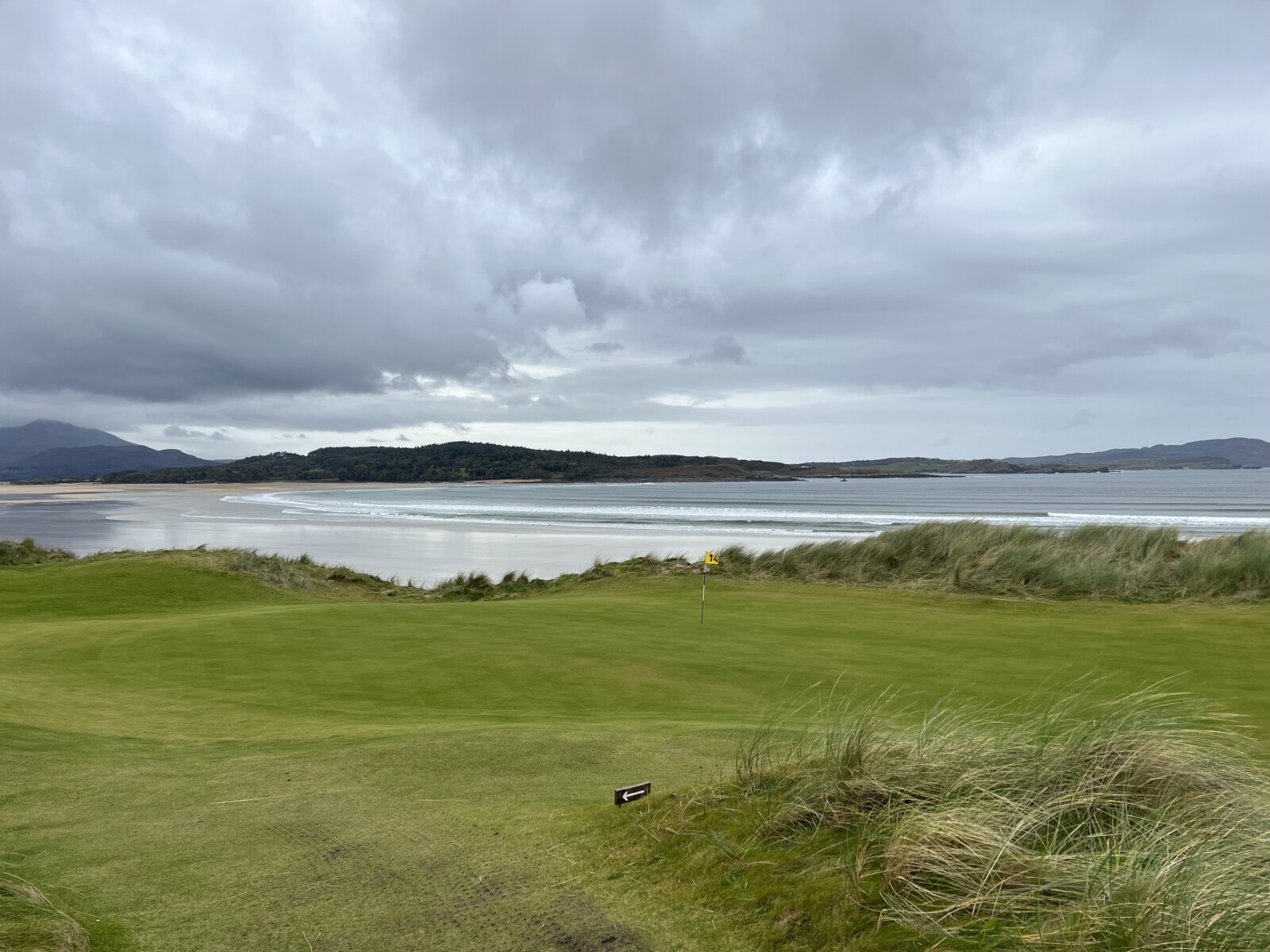
Many of the fairways seem to run into the greens without great distinction between the two – although that will no doubt change in the summer and when the greens are able to be cut shorter – but it certainly gave me all the encouragement I needed to get the putter out from the fringes and beyond. Unlike many traditional links, many of the vast greens present some devilish slopes, and while there will no doubt be some who say they are not typical of the genre, they could never accuse them of being boring.
The fourth and the fifth are the only two holes running in the same direction, so the only two holes with the wind in the same direction. There is good variety in the par 3s too. None of them plays over 180 yards from the middle tees, but they play in three different directions, with both uphill and downhill settings. If variety is the spice of life, St Patricks Links ticks plenty of boxes on that score, with no hole remotely resembling another.
The highlight on the back nine is undoubtedly 14, a sweeping dogleg par 4 that demands that you hit your drive directly towards the sea, before turning right to hit an a long-iron approach to a well-guarded green that is perched just yards from the beach. That is swiftly followed by a dinky, uphill 130-yard par 3, where only the very top of the flag can be seen from the tee. The 16th is a 487-yard downhill, par 4 whose fairway pinches in dramatically around the 300-yard mark where a par will feel hard won. The round, to my mind, finishes with a whimper than bang with the 170-yard, par-3 17th and the 350-yard, par-4 18th, neither setting the pulses racing or feeling like the round was reaching a crescendo.
Wearing my most balanced of hats, St Patricks Links has some truly stunning holes and is located a dramatic piece of land, but there are some forgettable holes, and the course conditioning – especially those greens – means that it will be some time before a proper assessment of its merits as a golfing experience, especially when it comes to value for money – the green fee is €200 – can be made. The absence of its own clubhouse and much in the way onsite off-course facilities only adds to the feeling that those who insisted on playing here on opening came away feeling a little short-changed, but there’s no doubting that this course will be a must-play on any itinerary to this part of the world in the years to come.
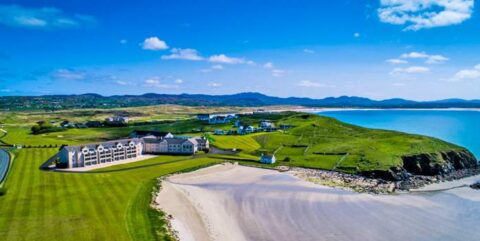
Later that evening, camped in the bar of the Rosapenna Hotel, I reunited with my golfing colleagues to swap tales of our respective rounds. They had played at North West Golf Club, a 130-year old private members’ club located on the shores of Lough Swilly, where 18 holes jostle for attention on a narrow stretch of land between the water and. Described as the ‘St Andrews of Ireland’, due to its rumpled fairways and fescue greens, they said it provided a suitably gentler test than what came before.
The following morning, refuelled by a full Irish breakfast, we set off in search of Portsalon Golf Club, the final stop on my itinerary. The 15-mile drive took us through some spectacular scenery, with the narrow roads twisting and turning around the shores of Mulroy Bay and Kincrum Lough, before emerging at Portsalon Beach and its eponymous golf club.
With the tide out on Ballymastoker Bay, the sun shining through wispy clouds, and the wind a mere zephyr, conditions were just about perfect for my final outing of the trip. One of the nine founding clubs of the Golf Union of Ireland, golf has been played at Portsalon since the 1891, and although the course was significantly remodelled in 2000 – by that man Pat Ruddy again – it has been providing a fine test of golf for local golfers and a steady stream of visitors for over 130 years.
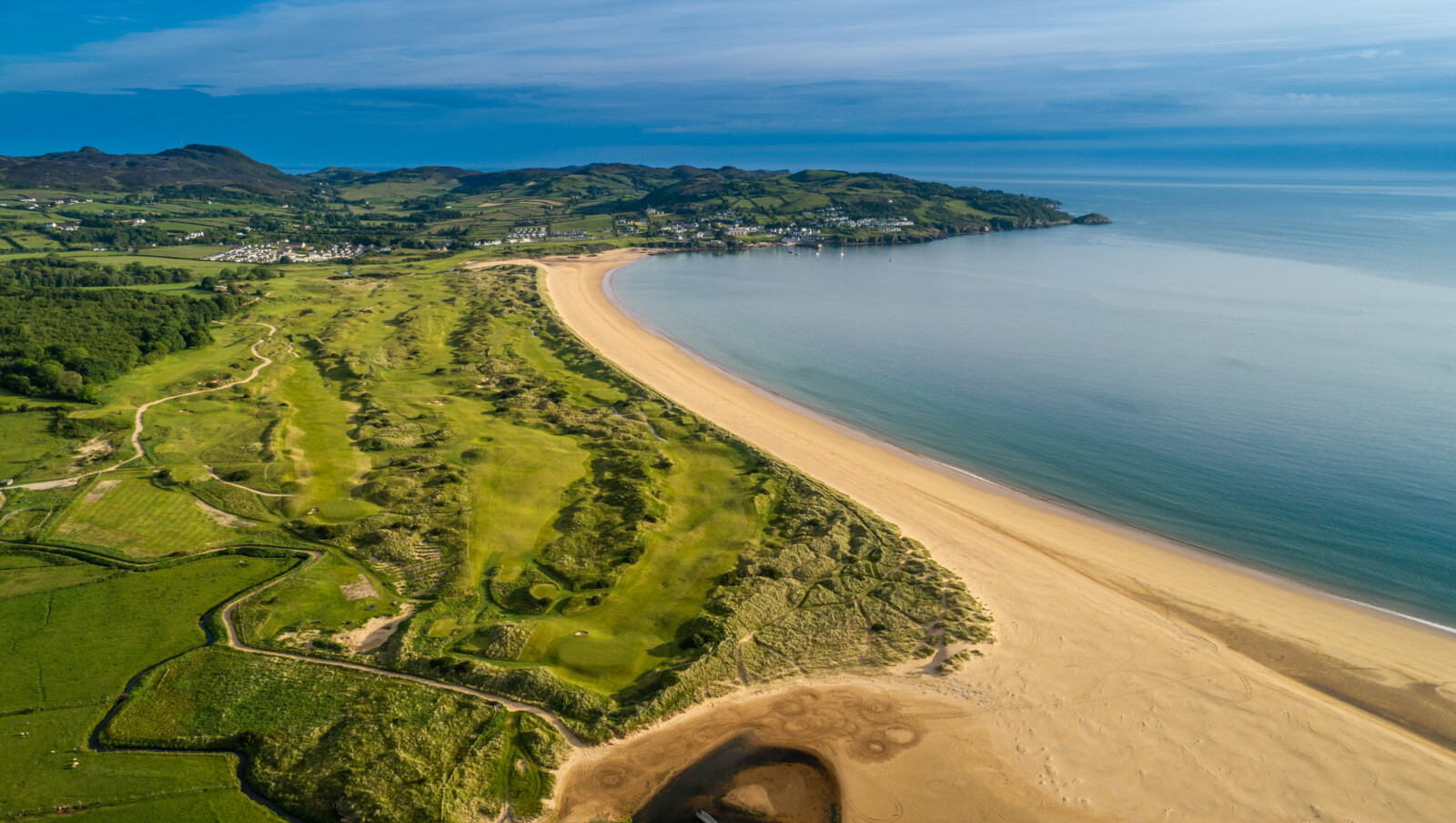
At just over 6,193 yards off the back tees, yet still playing to a par of 72, Portsalon is a refreshingly short course, where the challenge is not in the length off the tee, but in finding the right part of the fairway from which to attack the often well-guarded greens.
Among half a dozen standout holes, the second, a 390-yard par four, is an early highlight with the raised tee providing a stunning, if somewhat distracting view out over the bay, while the fairway below curves gently around the beach. The challenge is to judge just how much of the beach you want – or are able – to carry – with the braver shot leaving a much shorter shot to the green. I baled out right, waaaaay right, and had to lay up with my second in front of a tidal inlet that fronts the green and was happy to walk off with a five and my ball still intact.
The next five holes run alongside the sea, with the 4th – ‘Valley’ presenting a gun barrel straight par-5 with towering dunes on either side, and the 5th, a long par-three, being personal favourites. The 3rd shares a green with the 9th, as does the 4th with the 8th, giving the course even more of a St Andrews vibe, while also serving to create a modicum of confusion for first-time visitors.
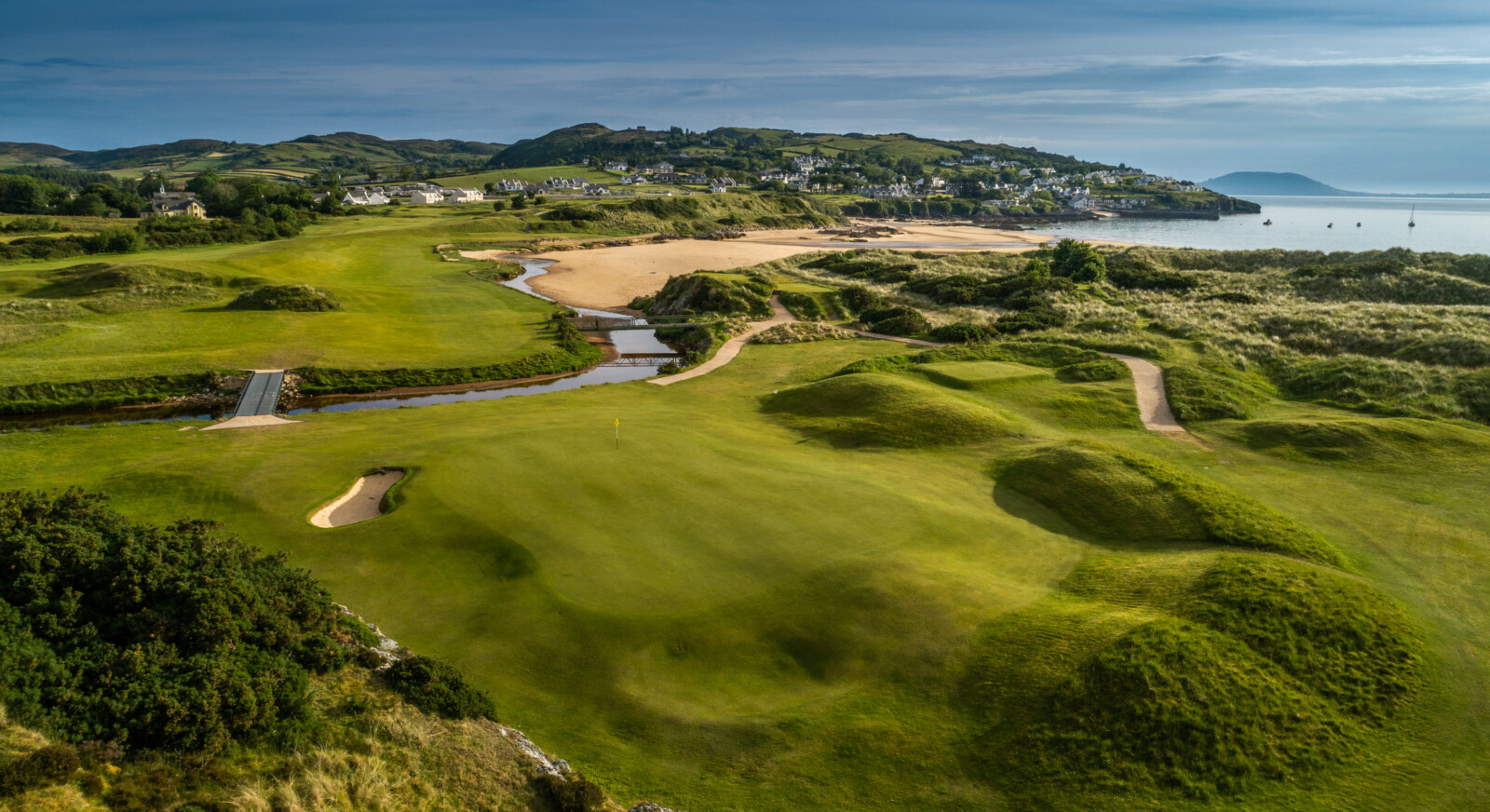
After the 7th, a short par-4 which features a devilish upturned saucer of a green, the course turns back slightly inland as it heads back towards the clubhouse through a fine mix of still very linksy, natural holes which feature more elevation changes and the occasional blind tee shot. The final two holes are both played uphill, with the par-five 17th requiring three decent blows to reach the raised green, while 18 has a split-level fairway to negotiate – take the right-hand one for a better view of the green. A deep channel in front of the green – which, somewhat bizarrely, is used to allow pedestrians to walk through to the beach – would be sure to gobble up any balls were it not for a heavy-duty mesh netting that prevents an under-hit approach from taking out an unsuspecting surfer.

All told, Portsalon is an absolute joy to play from start to finish. It’s a proper links, but its length makes it playable for all levels of golfer, while there are plenty of strategic options to allow for aggressive plays which carry their own risk and reward. On top of that, the somewhat rudimentary clubhouse provides a great view out over the bay and does a decent lunch and even better Guinness. And you can’t ask for more than that.
Of course, there are many more courses along the Wild Atlantic Way that I didn’t get to play – Ballyliffin’s Old Course, the Sandy Hills and Old Tom Morris courses at Rosapenna, and Narin & Portnoo being four off the bat – but the three I played have certainly whetted my appetite to come back for more of what delightful Donegal has to offer.
WHERE I PLAYED
Ballyliffin Golf Club
Green Fees: (midweek summer): Old Course €160; Glashedy Links €200
W: ballyliffingolfclub.com T: +353 74 937 6119
Rosapenna Hotel & Golf Resort
Green Fees: Old Tom Morris €150, Sandy Hills €150, St Patricks Links €200 (Apr 14-Oct 22). A ticket for one round on all three costs €400, representing a saving of €100.
W: rosapenna.ie T: +353 74 915 5301
Portsalon Golf Club
Green Fees: €120
W: portsalongolfclub.ie T: +353 74 9159459
WHERE I STAYED
Ballyliffin Hotel
Situated on the Inishowen Peninsula, just five minutes from Ballyliffin Golf Club, this welcoming 3-star hotel is located in the heart of Ballyliffin and offers double and twin rooms with satellite TV, power shower, two restaurants and a bar. Prices from €260 per room for 2-night stays.
W: ballyliffinhotel.com
Rosapenna Hotel & Golf Resort
Overlooking Sheephaven Bay on the coast of Donegal, this four-star hotel dates back to the end of the 19th century and boasts a wide array of accommodation options, from classic rooms – which include two double beds and a sitting room area – to opulent suites with balconies overlooking the bay. It also offers an indoor pool, gym and spa and has two restaurants – the Coach House Bar and the Vardon Restaurant. Two-night B&B packages, including two rounds of golf, start from £405pp.
W: rosapenna.ie
For more information and details on golf breaks throughout Ireland, visit www.ireland.com/golf
The post DELIGHTFUL DONEGAL appeared first on Golf News.
Leave a comment